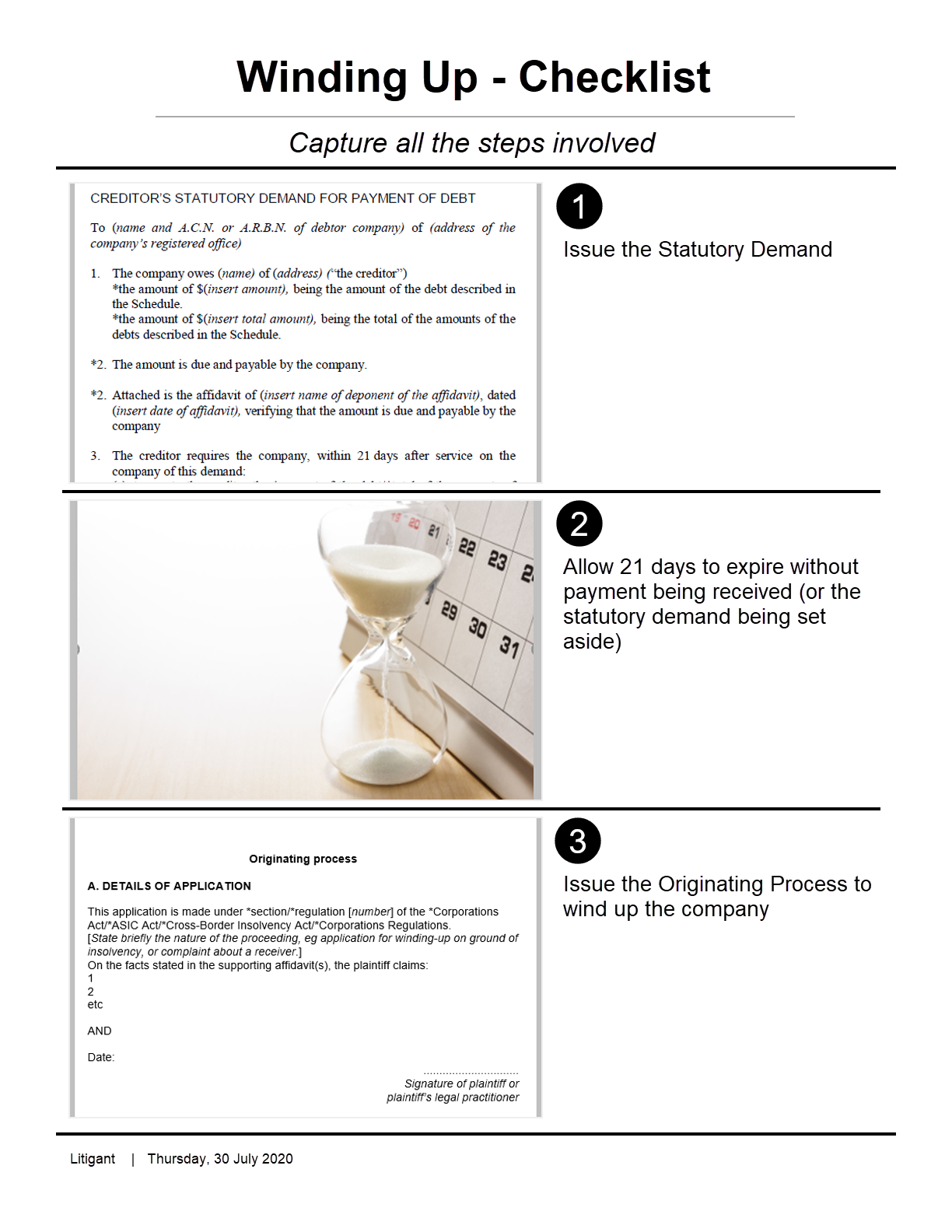Most of the winding up applications that end up before the court arise because a company is presumed to be insolvent because it failed to comply with a statutory demand before the expiry of 21 days (longer during Covid 19). This guide provides a basic overview of how a winding up in insolvency works where there is such a failure to comply with a statutory demand.
Here are some headings:
- What is a winding up of a company?
- For what reasons can a company be wound up?
- How does a presumption as to insolvency arise?
- Who can bring the application to wind up a company?
- Where is the application brought?
- What are some of the procedural matters?
- The winding up order
- How does Litigant help with a winding up?

What is a winding up of a company?
When a company is wound up a liquidator is appointed in the place of the board of directors to realise the assets of the company, and if possible pay the debtors by way of a dividend. At the end of the process the company ceases to exist and is deregistered.
For what reasons can a company be wound up?
A company may be wound up for a range of reasons including:
- insolvency – whether for actual or presumed insolvency.
- oppression – where the affairs of the company are conducted in a manner that is against the interests of members as a whole.
- by resolution – such as when the creditors resolve that a company under voluntary administration should be wound up
- for just and equitable reasons – this could apply in circumstances where the company doesn’t have proper management.
How does a presumption as to insolvency arise?
Under the Corporations Legislation a company can be presumed to be insolvent in certain circumstances and relevantly where it fails to pay the amount sought under a statutory demand (or fails to set it aside) within the relevant period. This is the most common reason why companies end up being placed into liquidation.
Who can bring the application to wind up a company?
The application is usually brought by a creditor who issued the statutory demand that is neither paid nor set aside within the relevant period. As a presumption regarding insolvency lasts for 3 months, the application should be brought within this period (except during Covid 19 when a longer period applies)
Where is the application brought?
Many of these applications are brought either in the Federal Court of Australia or in the Supreme Court of New South Wales (noting Litigant is based in Sydney, New South Wales). There can be some advantages to proceeding in one court over the other including matters regarding convenience, likely timeframes within which the application will be dealt with and the costs of proceeding in one court over the other.
What are some of the procedural matters?
Bringing an application to wind a company up in insolvency is a conceptually simplistic affair, however, the reality of proceeding on such an application is a technical exercise requiring some legal knowledge. In its most basic sense the application will be brought by a plaintiff and the defendant will be the company.
The application is brought by way of an originating process that needs to be supported by an affidavit. The originating process needs to comply with a range of matters that include the provision of particulars of the demand and the fact (assuming that to be the case) that it was not complied with. There are also technical requirements about the timing for attaching a company search with respect to the entity being wound up. Additional requirements relate to obtaining the consent of a liquidator and properly serving the application to wind a company up and publishing the appropriate notices with ASIC.
The winding up order
If the procedural steps are complied with, and the company is unable to rebut the presumption as to insolvency then it is likely that the court will make a winding up order. Winding up spells the end of the company when assets are collected and if anything remains there may be a distribution to creditors by way of a dividend.
At the end of the process, after the order has been made and the liquidator has carried out all the necessary work, the company will come to an end and be deregistered.
How does Litigant help with a winding up?
For debts that exceed $100,000, our law firm can assist with the preparation of the letter of demand seeking payment of the debt, issuing a statutory demand upon the creditor and then preparing the winding up application should the debt remain unpaid. Alternatively, other enforcement steps can be considered should it be necessary to levy property or take other steps.
In circumstances where the defendant is solvent, and capable of paying legal costs, we can assist by opposing the winding up application where there are grounds to do so.
Talk to a Dispute Lawyer today!

* Disclaimer:- This publication contains general information which may not suit your particular needs or circumstances. It may be summarised and include generalisations. Details that may be important in your specific circumstances might not be included. Litigant strives to ensure that the information in this publication is accurate and up-to-date, but does not represent or guarantee that it is accurate, reliable, current, complete or suitable. You should independently evaluate and verify the accuracy, reliability, currency, completeness and suitability of the information, before you rely on it. The information in this publication is not legal or other professional advice. You should obtain independent legal or professional advice that is tailored to your particular circumstances if you have concerns. To the maximum extent permitted by law, Litigant excludes liability for any loss, however caused (including by negligence), relating to or arising directly or indirectly from using or relying on any content in this publication. Litigant asserts copyright over the content of this publication.
